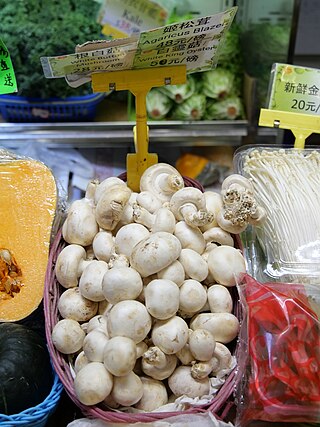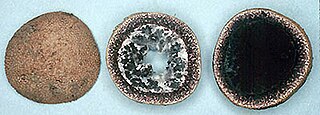
Mycology is the branch of biology concerned with the study of fungi, including their genetic and biochemical properties, their taxonomy and their use to humans, including as a source for tinder, traditional medicine, food, and entheogens, as well as their dangers, such as toxicity or infection.

Edible mushrooms are the fleshy and edible fruit bodies of several species of macrofungi. They can appear either below ground (hypogeous) or above ground (epigeous) where they may be picked by hand. Edibility may be defined by criteria that include absence of poisonous effects on humans and desirable taste and aroma. Edible mushrooms are consumed for their nutritional and culinary value. Mushrooms, especially dried shiitake, are sources of umami flavor.
An ascocarp, or ascoma, is the fruiting body (sporocarp) of an ascomycete phylum fungus. It consists of very tightly interwoven hyphae and millions of embedded asci, each of which typically contains four to eight ascospores. Ascocarps are most commonly bowl-shaped (apothecia) but may take on a spherical or flask-like form that has a pore opening to release spores (perithecia) or no opening (cleistothecia).

A truffle is the fruiting body of a subterranean ascomycete fungus, predominantly one of the many species of the genus Tuber. In addition to Tuber, over one hundred other genera of fungi are classified as truffles including Geopora, Peziza, Choiromyces, and Leucangium. These genera belong to the class Pezizomycetes and the Pezizales order. Several truffle-like basidiomycetes are excluded from Pezizales, including Rhizopogon and Glomus. Truffles are ectomycorrhizal fungi, so they are usually found in close association with tree roots. Spore dispersal is accomplished through fungivores, animals that eat fungi. These fungi have significant ecological roles in nutrient cycling and drought tolerance.
3 Musketeers is a chocolate bar made in the United States and Canada by Mars, Incorporated. It is a candy bar consisting of chocolate-covered, fluffy, whipped nougat. It is a lighter chocolate bar similar to the global Milky Way bar and similar to the American version Milky Way bar only smaller and without the caramel topping. The 3 Musketeers Bar was the third brand produced and manufactured by M&M/Mars, introduced in 1932. Originally, it had three pieces in one package, flavored chocolate, strawberry and vanilla; hence the name, which was derived from the 1844 novel The Three Musketeers by Alexandre Dumas. Rising costs and wartime restrictions on sugar saw the phasing out of the vanilla and strawberry pieces to leave only the more popular chocolate. Costing five cents when it was introduced, it was marketed as one of the largest chocolate bars available, one that could be shared by friends.
Fungiculture is the cultivation of fungi such as mushrooms. Cultivating fungi can yield foods, medicine, construction materials and other products. A mushroom farm is involved in the business of growing fungi.

A chocolate truffle is a type of chocolate confectionery, traditionally made with a chocolate ganache centre coated in chocolate, cocoa powder, coconut, or chopped and toasted nuts, usually in a spherical, conical, or curved shape.

Tuber brumale, also known as Muscat truffle or winter truffle, is a species of truffle native to Southern Europe. It is naturally present in the soils of many truffle orchards.
Milk Tray is a brand of boxed chocolates currently manufactured by Cadbury. Introduced by Cadbury UK in 1915, it is one of the longest running brands in the confectioner's portfolio. Milk Tray is sold in Australia, Canada, Ireland, New Zealand, New York City, South Africa and the United Kingdom.

A false truffle or a hymenogastrale is any species of fungus that has underground fruiting bodies that produce basidiocarps resembling the true truffles of genus Tuber. While rodents such as squirrels eat a wide variety of false truffle species, many are considered toxic or otherwise unpalatable and only a few are sought after as food.

Tuber oregonense, commonly known as the Oregon white truffle, is a species of edible truffle in the genus Tuber. Described as new to science in 2010, the North American species is found on the western coast of the United States, from northern California to southern British Columbia west of the Cascade Range. A mycorrhizal fungus, it grows in a symbiotic association with Douglas fir. It overlaps in distribution with the closely related T. gibbosum, but they have different growing seasons: T. oregonense typically appears from October through March, while T. gibbosum grows from January to June. The fruit bodies of the fungus are roughly spherical to irregular in shape, and resemble small potatoes up to 5 cm (2 in) in diameter. Inside the truffle is the gleba, which is initially white before it becomes a marbled tan color. The large, often thick-walled, and strongly ornamented spores are produced in large spherical asci. The truffle is highly prized for its taste and aroma. Some individuals have claimed success in cultivating the truffles in Christmas tree farms.

Tuber gibbosum is a species of truffle in the genus Tuber. It is found in the Pacific Northwest region of the United States, where it grows in an ectomycorrhizal association with Douglas-fir. It is commercially collected between as early as October and into March.

Elaphomyces is a genus of hypogeous fungi in the family Elaphomycetaceae. The widespread genus contains 25 truffle-like species. Elaphomyces is one of the most important ectomycorrhizal fungal genera in temperate and subarctic forest ecosystems. E. asperulus, E. granulatus, and E. muricatus were found to accumulate arsenic ; the composition of organoarsenicals is very unusual, with methylarsonic acid and trimethylarsine oxide as major As compounds.

Kalapuya brunnea is a species of truffle in the monotypic fungal genus Kalapuya. The truffle occurs only in the Pacific Northwest region of the United States, in western Oregon and northern California. Known locally as the Oregon brown truffle, it was formerly thought to be an undescribed species of Leucangium until molecular analysis demonstrated that it was distinct from that genus. The truffle is reddish brown with a rough and warty outer skin, while the interior spore-producing gleba is initially whitish before developing greyish-brown mottling as it matures. Mature truffles have an odor resembling garlicky cheese, similar to mature Camembert. The species has been harvested for culinary purposes in Oregon.
Tuber anniae is a species of truffle in the genus Tuber. The truffle is purported to be uncommon, but is primarily found in the United States Pacific Northwest. Recently the fruiting of closely related taxa have been found in the Baltic Rim countries, primarily forests dominated by Scots pine in eastern Finland.

Tuber melanosporum, called the black truffle,Périgord truffle or French black truffle, is a species of truffle native to Southern Europe. It is one of the most expensive edible mushrooms in the world. In 2013, the truffle cost between 1,000 and 2,000 euros per kilogram.
A tuber is a type of modified plant structure that is enlarged to store nutrients.

Leucangium carthusianum is a species of ascomycete fungus. It is commonly known as the Oregon black truffle. It is found in the Pacific Northwest region of North America, where it grows in an ectomycorrhizal association with Douglas-fir. It is commercially collected, usually assisted by a specially trained truffle dog. Mature fruiting bodies can be dug up mostly during winter, but the season can extend from September through April.

Tuber borchii, known as the whitish truffle or bianchetto truffle, is a small, common species of edible truffle excellent for use in cuisine.












